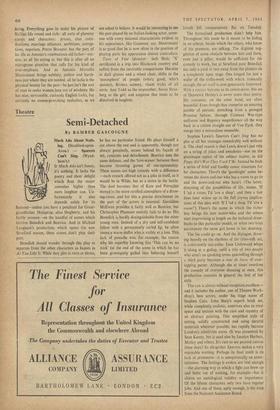Theatre
Semi-Detached
By BAMBER GASCOIGNE Much Ado About Noth- ing. (Stratford-upon- Avon.) — Sparrers Can't Sing. (Wynd- ham's.) Ir• Much Ado isn't funny, it's nothing. It lacks the poetry and sheer delight which float the major comedies higher than mere laughter can. Un- fortunately it also depends solely for its humour—unless you have a penchant for Great- grandfather Malaprop, alias Dogberry, and his feeble yeomen—on the handful of scenes which involve Benedick and Beatrice. And in Michael Langham's production, which opens the new Stratford season, these scenes, don't play their part.
Benedick should wander through this play as separate from the other characters as Jaques in As You Like It. While they plot in twos or threes, he has no particular friend. He plays himself a cut above the rest and is apparently, though not always genuinely, secure behind his facade of wit, cynicism and detachment. Beatrice uses the same defence, and the love-scenes' between them become thrusting games of one-upmanship. These scenes are high comedy with a difference —each remark offered not as a joke in itself, as it would be in Wilde, but as a move in the battle. The duel becomes that of Kate and Petruchio moved to the more rarefied atmosphere of a draw- ing-room, and for this a precise detachment on the part of the actors is essential. Geraldine McEwan provides it fairly well as Beatrice, but Christopher Plummer entirely fails to do so. His Benedick is hardly distinguishable from the other young men. Instead of a dry and Self-confident fellow with a permanently curled lip, he often seems a warm duffer who is visibly at a loss. This lack of panache was, for example, the reason why his superbly knowing line 'This can be no trick' (at the end of the scene in which he has been grotesquely gulled into believing himself loved) fell comparatively flat on Tuesday.
The formalised production didn't help him. Throughout this scene he is meant to be hiding in an arbour, beside which the others, who know of his presence, are talking. The slightest sug- gestion of some obstacle between him and them, even just a pillar, would be sufficient for the comedy to work, but at Stratford poor Benedick sits only a yard or two away from the plotters on a completely open stage. One longed for just a wafer of the trellis-work with which, ironically enough, the set itself is.over-generously festooned. With a rococo balcony as its centre-piece. this set of Desmond Heeley's is never more than pretty. His costumes, on the other hand, are often beautiful. Even though they comprise an amazing jumble of periods, stretching from a pronged Prussian helmet, through Crimean War-type uniforms and Regency magnificence all the way back to a citizen straight out of Van Eyck. they merge into a miraculous ensemble.
Stephen Lewis's Sparrers Can't Sing has no plot at all but manages remarkably well without it. The chief reason is that Lewis doesn't just rely on a string of jokes and anecdotes—nor on the picaresque aspect of his subject matter, as did Fings Ain't Wot They Used T'Be. Instead he finds a series of brief and freshly comic situations for his characters. There's the 'goodnight' scene be- tween the down-and-out who has a room to go to and the down-and-out who hasn't. (The latter, dreaming of the possibilities of life, muses, 'If I 'ad a room, I'd 'ave a shop'; and then a few lines later wakes up to the full joyous implica- tions of this idea with `If I 'ad a shop, I'd 'ave a room!') There's the scene in which the richer boy brings his new motor-bike and the others start improvising at length on the technical draw- backs to this particular model; or when two boys accompany the same girl home to her doorstep.
The list could go on. And the dialogue, draw- ing heavily on the rhythms of the cross-talk act, is consistently enjoyable. Joan Littlewood whips it along at a gallop, until a trio of two people who aren't on speaking terms quarrelling through a third party becomes a tour de force of over- lapping patter. Although she at times overdoes the comedy of everyone shouting at once, this production contains in general the best of her style.
The cast is almost without exception excellent— and it includes the author, one of Theatre Work- shop's best actors, under his stage name of Stephen Cato. John Bury's superb brick set, while completely realistic, contrives also to treat space and texture with the care and mystery of an abstract painting. This simplified style of setting, solidly constructed and using natural materials wherever possible, has rapidly become London's admirable norm. (It was pioneered by Sean Kenny, but is used also by Jocelyn Herbert, Motley and others. It's rare to see painted canvas these days.) So altogether Sparrers makes a very enjoyable evening. Perhaps its final merit is its lack of pretension—it is unequivocally an enter- tainment. The feelings it evokes are real enough —the alarming way in which a fight can brew up and burst out of nothing, for example—but it claims no sociological validity or importance. Of the fifteen characters only two have regular jobs. And one of these, aptly enough, is the man from the National Assistance Board.






































 Previous page
Previous page